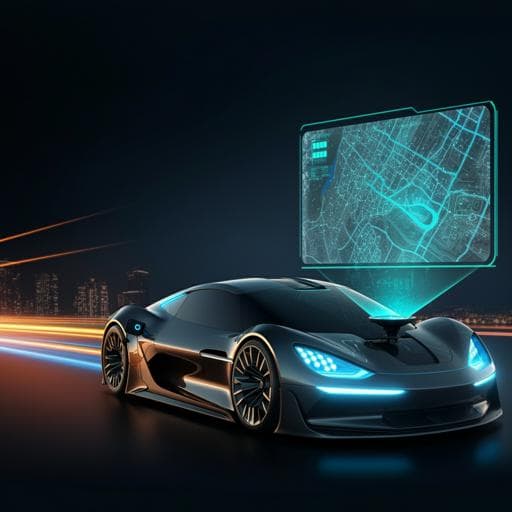
Transportation
Willingness to pay and attitudinal preferences of Indian consumers for electric vehicles
P. Bansal, R. R. Kumar, et al.
This groundbreaking research by Prateek Bansal, Rajeev Ranjan Kumar, Alok Raj, Subodh Dubey, and Daniel J. Graham explores how Indian consumers value electric vehicle attributes. Discover their willingness to pay for features that could influence the future of EV adoption in India.
~3 min • Beginner • English
Introduction
The transportation sector is a major and growing source of CO2 emissions in India, with vehicle demand projected to rise sharply. Although EVs are a promising alternative to ICEVs, adoption faces barriers such as high upfront costs, limited range, inadequate charging infrastructure, and low awareness—issues that are especially salient in India. Despite supply-side initiatives (e.g., NEMMP, FAME/FAME-II), EV car sales remain low, highlighting the importance of understanding consumer demand. The study investigates four research questions: (1) Which product, service, and policy attributes determine Indian car buyers’ preferences for EVs? (2) Which latent attitudinal factors (e.g., environmental concern, trust in EV technology, propensity to be an early adopter) affect EV adoption? (3) What are Indian consumers’ willingness to pay for improvements in EV attributes? (4) Do consumers evaluate EVs relative to ICEVs (reference dependence), and how does accounting for this affect WTP estimates? The paper contributes empirically by providing the first Indian estimates of WTP for EV attributes from a large SP survey, and methodologically by employing an ICLV model with a curvature-based reference-dependent utility specification that nests the standard model.
Literature Review
Recent discrete choice studies (largely in developed countries and China) estimate WTP for EV product/service attributes (range, charging time/infrastructure, cost) and examine policy incentives (e.g., lane access, fee waivers). Most use SP data due to limitations of RP data in observing choice sets and testing policies. Attitudinal factors such as environmental concern, risk aversion, trust in technology, awareness, hedonic/symbolic values, and social norms also influence EV preferences. In India, preference studies are sparse and often rely on SEM, regression, or qualitative approaches; few estimate WTP and none combine attitudes with reference dependence. Modeling approaches commonly include MNL and extensions (NL, MNP, Mixed-MNL, Latent Class). ICLV models can parsimoniously incorporate latent attitudes, address measurement error, support forecasting without direct attitudinal responses, and reveal sources of heterogeneity. Prior EV ICLV applications are limited and do not incorporate general reference dependence. Identified gaps: lack of Indian WTP estimates and omission of reference dependence alongside latent attitudes in EV preference modeling.
Methodology
A nationwide online stated preference (SP) survey (March–June 2020) presented respondents with hypothetical binary choices between an ICEV and a BEV (EV), with ICEV attributes serving as reference levels. The design pivoted EV price on each respondent’s stated reference ICEV price, and maintained realistic dominance relations between ICEVs and EVs (e.g., EVs always had higher purchase price, lower range). A randomized, attribute-level balanced design produced 24 scenarios; each respondent evaluated 3. Attributes and levels included: purchase price (EV priced at +30%, +45%, +60% over respondent’s ICEV price), running/operating cost (ICEV: INR 3–5/km; EV: INR 0.5–1.5/km), range (ICEV: 600/800 km; EV: 150/200/250 km), slow charging time (EV: 6/8/10 h), fast charging time (ICEV: 5/10 min; EV: 30/60/90 min), availability of fast-charging stations (EV: every 3/5/7 km within city; ICEV: 1 km), and policy privileges (reserved parking; specialised lanes). The survey also collected socio-demographics and 11 Likert-scale indicators on environmental beliefs, EV technology trust, early adoption propensity, EV knowledge, and social influence. After a pilot (N=110) and screening for short completion time, the final sample included N=1021 respondents across major Indian states and cities. The modeling framework is an Integrated Choice and Latent Variable (ICLV) model. The discrete choice component is a binary Probit with a reference-dependent, curvature-based utility: utility for EV attributes is expressed relative to the ICEV (reference) with diminishing sensitivity controlled by attribute-specific curvature parameters (α), nesting the linear specification when α=1. Loss aversion was not modeled due to design constraints (attributes always dominated in one direction). Latent variables—“climate doubters” (lower pro-environment stance), “EV-tech believers” (trust in EV technology), and “early adopters”—enter utility directly and via interactions with key attributes (price, range, operating cost). The SEM component models latent variables as functions of demographics via trivariate linear regression with correlated errors, and maps latent constructs to ordinal indicators via multivariate ordered Probit, also linking knowledge and social influence indicators to the latent variables. Estimation uses a composite marginal likelihood (CML) approach for computational tractability. WTP is computed as the ratio of marginal utilities with respect to the attribute and to price, accounting for nonlinearity and reference dependence; range enters in log form to ensure decreasing marginal utility.
Key Findings
- Significant determinants of EV choice: purchase price (relative to ICEV), driving range (log-transformed, relative), operating cost (weekly fuel/energy cost difference), and fast charging time. Slow charging time, density of fast-charging stations (within-city spacing), and privilege-driven policies (reserved parking, specialised lanes) were not statistically significant. - Evidence of reference dependence: curvature parameters for price, range, and operating cost were less than 1, indicating diminishing sensitivity relative to the ICEV reference (except fast charging time, which did not show diminishing sensitivity). Models with reference dependence improved fit over linear utility. - Attitudes and social factors: greater EV knowledge and stronger social influence (friends buying EVs) increased EV adoption likelihood. Climate doubters were less likely to choose EVs; early adopters were more likely. EV-tech believers preferred EVs when EV price parity with ICEV was closer and when EV range was higher; their preference weakened as EV price diverged upward from ICEV. Early adopters valued operating cost savings and range more and tolerated slightly higher EV purchase prices. - WTP estimates (converted to USD as reported by authors): • Fast charging time: US$10–34 additional purchase price per minute reduction. • Driving range: US$7–40 per additional km at a 200 km base range, with WTP decreasing as range increases (due to log utility). • Operating cost: US$104–692 additional purchase price to save US$1 per 100 km (based on average weekly distance ≈230 km). WTP varied with EV price, ICEV reference levels, and demographics through latent variables. - Fuel economy valuation: Implied annual discount rates from operating-cost WTP suggest consumers undervalue future fuel/energy savings; linear models overstated myopia, while the reference-dependent model implied lower (but still high versus market rates) discounting. - Demographic/SEM insights: Females showed stronger pro-environment orientation and higher likelihood to be early adopters despite somewhat lower trust in EV technology. Lower-income and less-educated respondents exhibited less trust in EV technology and were less convinced of EVs’ climate benefits. Unemployed respondents were less confident in EV technology and less likely to adopt early; self-employed showed greater early-adopter tendencies. A high error correlation (~0.8) between EV-tech belief and early-adopter latent variables indicates shared unobserved factors.
Discussion
The study answers the four research questions: (1) Product/service attributes—price, range, operating cost, and fast charging time—are key drivers of EV adoption for Indian consumers, whereas slow charging, charger density (as framed), and privilege-based policies had limited immediate effect. (2) Latent attitudes matter: pro-environment orientation, trust in EV technology, and early-adopter tendencies significantly shape preferences; knowledge and social influence further increase EV adoption likelihood. (3) WTP estimates quantify the trade-offs consumers are willing to make for faster charging, longer range, and lower operating costs, enabling data-driven design and pricing decisions. (4) Incorporating reference dependence yields better fit and more realistic, context-sensitive WTP that vary with reference (ICEV) attribute levels; linear models can misstate valuations (e.g., fuel savings). Policy relevance includes focusing efforts on improving salient product attributes and consumer knowledge rather than relying on privilege-based measures in early adoption stages. Marketing strategies can leverage social networks and target early adopters (e.g., female consumers) to accelerate diffusion. Automakers can use segment-specific WTP to prioritize range and charging performance within viable price points for targeted demographics.
Conclusion
This paper provides the first Indian estimates of WTP for EV attributes using an ICLV framework that integrates latent attitudes and reference-dependent utility. Indian consumers value reductions in fast charging time and improvements in range and operating cost, with WTP magnitudes broadly consistent with international evidence when adjusted for context. Accounting for reference dependence yields more realistic, attribute- and context-dependent WTP. The findings inform EV design, pricing, marketing, and policy—highlighting the primacy of core product attributes and the role of consumer knowledge and social influence. Future research should: (1) obtain or construct representative demographic distributions of Indian car owners/buyers to enable weighting or sampling for representativeness; (2) validate on larger, more diverse samples across India; (3) expand attributes (e.g., body type, emissions, performance metrics); and (4) integrate supply-side behavior and market equilibrium models to simulate policy impacts (e.g., feebates) and substitution effects.
Limitations
- Sample representativeness cannot be confirmed due to lack of demographic benchmarks for Indian car owners/buyers; online, English-language sampling likely over-represents higher-income/education groups. - Stated preference data may not fully reflect real-world behavior; ICEV–EV comparisons were constrained so that attributes dominated in one direction, precluding explicit loss aversion estimation. - Only BEVs were considered; plug-in hybrids and other fuel types were not included. - Attribute set excludes vehicle body type, emissions, acceleration/top speed; charger density framing (urban spacing) may not capture real availability perceptions. - Reference dependence and latent variables are modeled with specific functional forms; generalization to different contexts requires caution.
Related Publications
Explore these studies to deepen your understanding of the subject.







